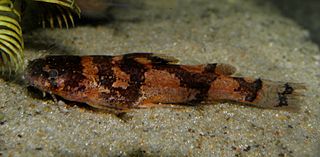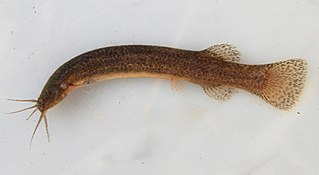
Hypostomus is a genus of catfish in the family Loricariidae. They are native to tropical and subtropical South America. H. plecostomus is the popular freshwater aquarium fish formerly known as Plecostomus plecostomus. The taxonomic structure of the Loricariidae is still being expanded by scientists. Hypostomus is a highly species-rich and widely distributed catfish genus.

Astyanax is a genus of freshwater fish in the family Characidae of the order Characiformes. Some of these fish, like many of their relatives, are kept as aquarium pets and known collectively as tetras. With around 150 described species and new ones being described yearly, this genus is among the largest of the entire order; Hyphessobrycon also has more than 145 species and which one is larger at any one time depends on whether more species have been recently described in one or the other. The blind and colorless cave tetra of Mexico is a famous member of the genus, but its taxonomic position is disputed: Some recognize it as part of the Mexican tetra and this is supported by phylogenetic evidence, but others recognize the cave form as a separate species, A. jordani.

The Pimelodidae, commonly known as the long-whiskered catfishes, are a family of catfishes.

Rineloricaria is a genus of freshwater tropical catfish belonging to the family Loricariidae. They are commonly called whiptail catfish because of the long filament that grows out of the tip of the caudal fin that is characteristic of the genus. With the exception of R. altipinnis from Panama, they are native to the rivers of northern and central South America. Some species are regularly seen in the aquarium trade.

Microglanis is a genus of fish in the family Pseudopimelodidae native to South America. This genus has the widest distribution within its family, with species ranging from the Guianas to Venezuela; western slope of the Andes in Ecuador and Peru to the Río de La Plata basin in Argentina. They occur eastward to the Orinoco and Amazon basins. It is also present in the eastern coastal rivers of Brazil.
Propimelodus is a genus of South American catfish of the family Pimelodidae.

Farlowella is a genus of fish in the family Loricariidae native to South America. This genus is broadly distributed in Amazon, Orinoco, Paraná and coastal rivers of the Guyana Shield. It is absent from the Pacific slope of the Andes and from the coastal rivers of the Brazilian Shield. Many of these species are kept in aquariums. This genus has a unique body shape that resembles a thin stick of wood. The body is slender and elongate, often with a pronounced rostrum and a brownish color with two lateral dark stripes beginning at the tip of the rostrum, passing over the eyes and ending at the tail, which are periodically interrupted on the caudal peduncle.
Hisonotus is a genus of armored catfishes native to South America. Species of Hisonotus and Curculionichthys are the only representatives of the subfamily Otothyrinae having serrae on the posterior edge of the pectoral fin spine. These species are small fishes, generally found in small fast flowing streams, where they grasp to the branches and leaves of aquatic or subaquatic plants. The species of this genus mostly occur in Atlantic coastal streams of southern Brazil and the Paraguay-Paraná system of southern South America. They are also distributed in the Río de La Plata basin and coastal rivers of southeastern Brazil.
Harttia is a genus of armored catfishes native to South America.
Pareiorhaphis is a genus of catfish in the family Loricariidae native to South America. This genus can be readily distinguished from other neoplecostomines by the unique combination of having fleshy lobes on lateral margins of head ornamented with hypertrophied odontodes on nuptial males, caudal peduncle ovoid in cross section, abdomen usually naked, dorsal fin spinelet ovoid and adipose fin usually present. The color pattern is usually dark brown and mottled with the abdomen white. Most species in to Pareiorhaphis were originally described in Hemipsilichthys. In 1918, Alípio de Miranda-Ribeiro proposed the new genus Pareiorhaphis. Whether Pareiorhaphis is monophyletic or not is currently unknown.
Neoplecostomus is a genus of fish in the family Loricariidae native to South America. Neoplecostomus can be distinguished from all other loricariids by a modified shield of small plates on the abdomen with posteriorly directed odontodes; the shield appears to act as a holdfast. The color pattern is generally mottled brown with the abdomen white. The head is long, rounded, and shovel-shaped. The fin spines are weak. They range from about 8 to 11 cm (3.1–4.3 in) SL. The species of Neoplecostomus live in fast-flowing water.

Ituglanis is a genus of small freshwater fish in the family Trichomycteridae native to South America. Their greatest diversity seems to occur in the Amazon River basin. Most species inhabit leaf litter, with several species living in caves.
Pimelodus pohli is a species of catfish belonging to the family Pimelodidae. It is only found in the São Francisco River, Brazil, and its tributaries.

Ageneiosus is a genus of driftwood catfishes found mostly in South America with one species extending into Central America.
Tympanopleura is a genus of driftwood catfishes found mostly in South America with one species extending into Central America.

Moenkhausia is a genus of freshwater fish in the family Characidae native to tropical and subtropical South America. These are medium-sized tetras where the largest species only reach around 12 cm (4.7 in).

Bryconamericus is a genus of characins found in Central and South America.

Characidium is a genus of fish in the family Crenuchidae. They are mainly found in South America, but C. marshi is from Panama. They are small, slender fish that live on the bottom in flowing fresh waters and feed on small animals such as insects.
Steindachnerina is a genus of toothless characins from South America, with 24 currently described species:











